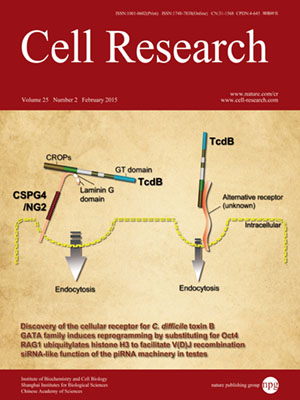
Volume 25, No 2, Feb 2015
ISSN: 1001-0602
EISSN: 1748-7838 2018
impact factor 17.848*
(Clarivate Analytics, 2019)
Volume 25 Issue 2, February 2015: 181-192
ORIGINAL ARTICLES
RAG1-mediated ubiquitylation of histone H3 is required for chromosomal V(D)J recombination
Zimu Deng1, Haifeng Liu1 and Xiaolong Liu1
1State Key Laboratory of Cell Biology, Institute of Biochemistry and Cell Biology, Shanghai Institutes for Biological Sciences, Chinese Academy of Sciences, Shanghai 200031, China
Correspondence: Xiaolong Liu, Tel: +86-21-54921176 Fax: +86-21-54921178(liux@sibs.ac.cn)
RAG1 and RAG2 proteins are key components in V(D)J recombination. The core region of RAG1 is capable of catalyzing the recombination reaction; however, the biological function of non-core RAG1 remains largely unknown. Here, we show that in a murine-model carrying the RAG1 ring-finger conserved cysteine residue mutation (C325Y), V(D)J recombination was abrogated at the cleavage step, and this effect was accompanied by decreased mono-ubiquitylation of histone H3. Further analyses suggest that un-ubiquitylated histone H3 restrains RAG1 to the chromatin by interacting with the N-terminal 218 amino acids of RAG1. Our data provide evidence for a model in which ubiquitylation of histone H3 mediated by the ring-finger domain of RAG1 triggers the release of RAG1, thus allowing its transition into the cleavage phase. Collectively, our findings reveal that the non-core region of RAG1 facilitates chromosomal V(D)J recombination in a ubiquitylation-dependent pathway.
10.1038/cr.2015.1
FULL TEXT | PDF
Browse 2148


